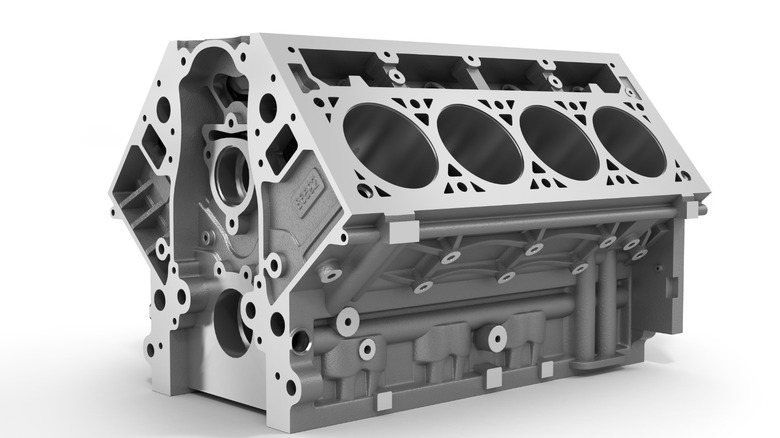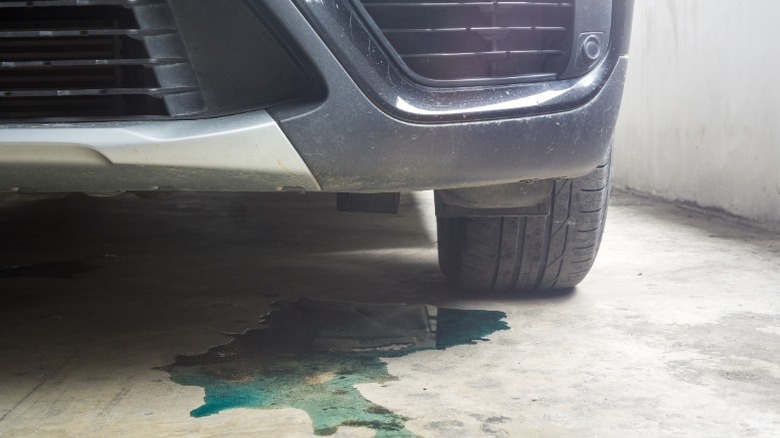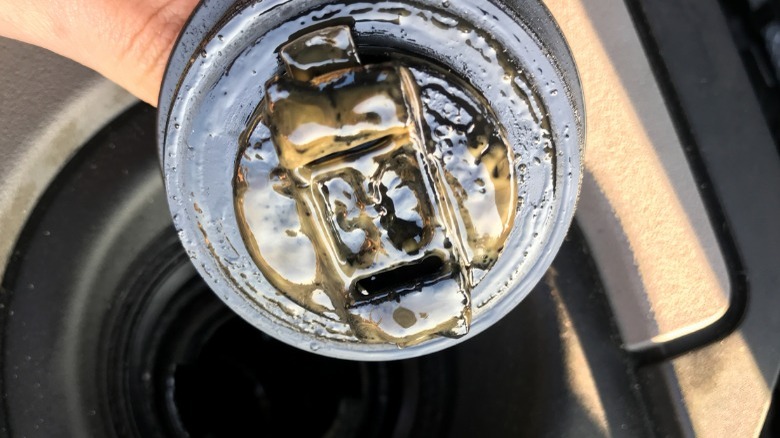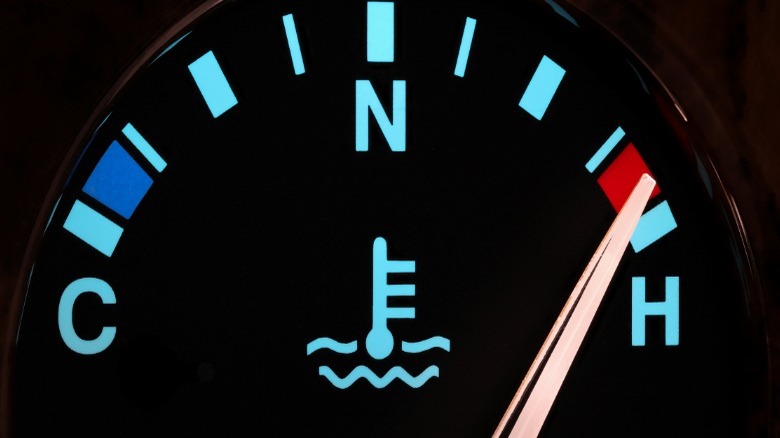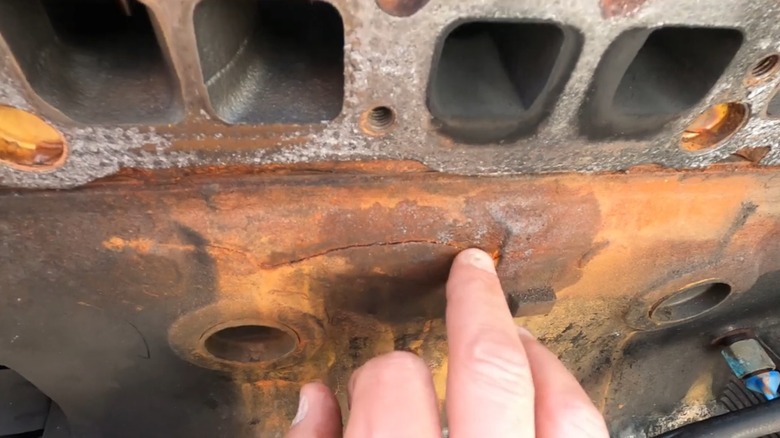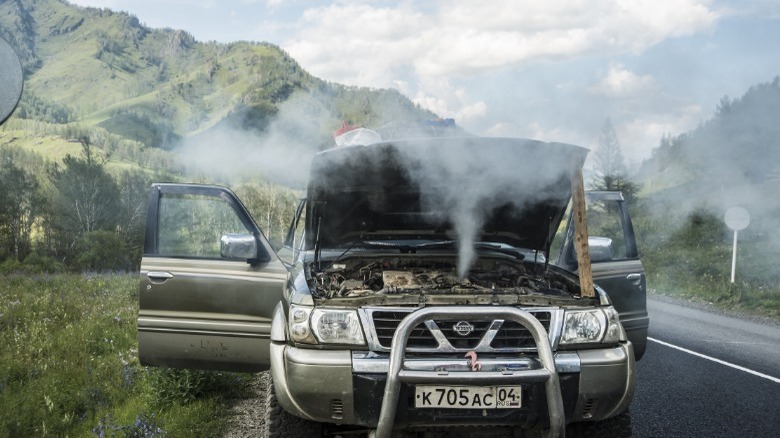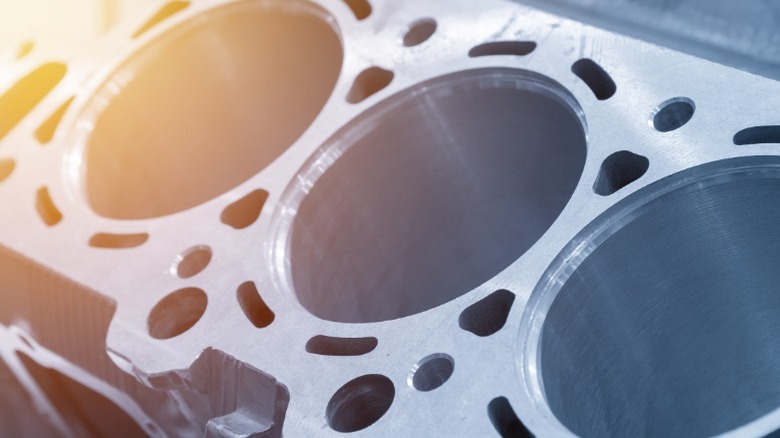6 Signs And Symptoms Of A Cracked Engine Block
Your car's internal combustion engine relies on a huge number of large, small, and oddly-shaped parts. One of the biggest and most important parts of your motor is the engine block or cylinder block, which may be built from cast iron or aluminum depending on your vehicle. It functions as the lower half of the motor and houses critical components like the crankshaft, pistons, and, in the case of some pushrod motors, the camshaft. The engine block also contains a network of passages through which coolant flows to absorb excess engine heat, as well as the cylinder bores and oil passages. The cylinder head bolts to the top of the engine block, while the oil pan connects to the bottom. Together with various accessories and pulleys, these components form the image most of us picture when thinking of modern car motors.
The engine block plays a critical role in the combustion process and helps contain vital components while holding the entire engine together. However, that importance also means that when something breaks, it can have a ripple effect that causes immense amounts of serious and costly damage. Unfortunately, there isn't much you can do for things like severe cracks, so it's important to be aware of the warning signs of a cracked engine block to catch the problem before it breaks. As a former professional mechanic and lifelong gearhead, I'll break down the most common signs and symptoms of a cracked engine block in simple terms.
A common sign of a cracked engine block is a coolant or oil leak.
We mentioned that the block contains a complex network of coolant passages. Those channels carry coolant — a mixture of water and antifreeze — through the block, surrounding the cylinders and crankcase, to absorb excess heat from the engine. The engine block also contains numerous oil passages, which allow motor oil to lubricate the various moving parts housed inside the block. When the engine is running, your car's cooling system is working constantly to pump coolant through the block. The same applies to the lubrication system. However, if the engine block becomes damaged by a crack, coolant or oil may begin to spill outside of those contained passages.
A cracked engine block may cause a visible coolant leak that leaves crusty buildup in your engine bay or brightly-colored, sweet-smelling puddles beneath your car, while an oil leak tends to leave dark, greasy patches inside the engine bay or grimy puddles under the vehicle. However, a cracked engine block can also cause an internal coolant leak, which can be difficult to identify. The best way to detect things like internal coolant or oil leaks early is to perform your own maintenance regularly or visit a professional routinely to do so for you. It's also worth remembering that various mechanical problems can cause oil leaks and coolant leaks. If your car develops these symptoms, the best move is to visit a repair shop for an inspection.
A cracked engine block can mix oil and coolant
So, if a cracked engine block can cause an internal leak, where exactly does the leaking fluid go? The answer to that question leads us to our next symptom of engine block damage: oil and coolant mixed together. This issue may take the form of coolant in your oil or oil in your coolant, and it's often the result of an internal fluid leak caused by a cracked engine block.
The issue occurs if the block becomes warped or cracked and allows fluid to escape its designated channels. You may not notice the problem immediately. Usually, people recognize the issue while performing routine maintenance like oil changes or coolant flushes. The most common sign of this problem is oil that looks milky and frothy or coolant that has oil in it. You may notice that your engine oil dipstick is covered in a thick, milky substance or that your coolant reservoir is significantly more dirty than usual.
Unfortunately, by the time you notice this issue, the damage is done, and you'll most likely face high repair costs. That said, it's always worth visiting a mechanic, as you may be able to Band-Aid-fix the problem in order to avoid immediate expenses. It's also worth noting that other problems besides a cracked engine block — notably, blown head gaskets — can cause your oil and coolant to mix, and you should prioritize getting a professional inspection to identify the damage definitively.
Engine overheating is another symptom
If your engine block is cracked and leaking oil or coolant, chances are you're going to have engine overheating problems. There are two primary ways this type of damage can cause your motor to overheat. The first way is the most obvious: A coolant leak means your car's cooling system won't be able to absorb and remove excess engine heat effectively, resulting in an overheating engine.
The second way that a cracked engine block can cause overheating is through an oil leak. Most people are familiar with motor oil and the job it performs as a lubricant. However, many people may not realize that oil also helps prevent overheating in two ways. By acting as a lubricant, motor oil prevents the buildup of excess friction, which can cause lots of heat. Oil also functions as a heat sink by absorbing heat and carrying it away from the engine and its sensitive components. In this regard, oil works in a way similar to coolant. It's because of those two secondary functions that an oil leak can cause overheating.
Although various problems can cause your car's engine to overheat, this is one of the most common causes of cracked and warped engine blocks. Any time you notice your engine temperature gauge beginning to climb, or you notice any other symptoms of a hot motor, you should visit a professional mechanic. Doing so early can help prevent more serious problems, like full-blown engine block cracks.
You can also visibly see an engine block crack
The next symptom of a cracked engine block that we'll cover is somewhat self-explanatory: visible physical damage to the block itself. Nevertheless, it can be difficult to notice, identify, and diagnose, especially if you don't perform your own maintenance. That's because the engine block isn't easily visible or accessible from the top of the engine bay in most vehicles and if you want a clear, unobstructed view, you need to remove it.
However, removing the engine just to perform a visual inspection is highly inefficient. Instead, professional technicians and seasoned home mechanics rely on a combination of car knowledge and tools like flashlights and telescoping mirrors. It may be impossible to get a clear view of every inch of the block, but checking it from a variety of angles — both above and below the engine bay, and with the proper tools — can provide a lot of insight.
Visible damage to the engine block usually takes the form of cracks large enough to see with the naked eye. However, to notice and diagnose visible engine block damage, your vehicle needs to be relatively clean. There are some tips you can use to keep your engine bay clean during your day-to-day routine. However, if the bay is already filthy and you want to perform a detailed inspection for damage, you should clean your engine bay before you start looking for cracks or other malfunctions.
A cracked engine block can alter your car's performance
Each of the different symptoms of a cracked engine block can contribute to a drop in your car's performance. However, a badly cracked block can also cause a loss of engine compression. Engine compression refers to the pounds per square inch (PSI) of pressure applied to the mixture of gas and oxygen in the combustion chambers. If the block cracks, it can cause a drop in compression, leading to various performance problems and an unpleasant or impossible driving experience.
Some of the performance issues you may face if your engine block cracks include things like engine misfires, poor acceleration, a check engine light, and general rough running. The problem is that these same problems can also be the result of various other engine flaws and malfunctions. If your car's performance begins to drop suddenly and unexpectedly, you should visit a professional mechanic. A technician will know what to look for and how to check off potential culprits in the most probable order.
If your poor performance is caused by a cracked engine block, you'll most likely have to pay to replace it. However, if the issue is the result of something more innocuous, visiting a mechanic and catching the problem early may allow you to fix the problem before it turns into something far more severe and costly.
It may cause smoke to come from the engine bay or exhaust
If your car's engine block is severely cracked, you may notice thick white smoke or steam billowing out from under the hood or from your car's tailpipe. This issue generally occurs when an engine block has already sustained extreme damage, meaning that if you encounter this problem yourself, your engine, or at least the block, is most likely beyond repair.
The issue occurs when a crack allows coolant to escape its designated passages and seep into the engine's cylinders or combustion chambers. When that happens, the coolant can get burned by the immense heat of the combustion process, causing thick plumes of white smoke and steam to begin spilling out of the engine bay. If the problem is severe enough, you may also notice smoke and steam pouring out of your car's exhaust, too. When that occurs, the smoke may have a faintly sweet odor, similar to the way unburnt coolant smells.
Remember, though, that smoke and steam coming from under your car's hood or from its exhaust can indicate numerous other problems, including simple overheating and emissions issues. If you start noticing smoke coming from under the hood, or you see excessive amounts of smoke coming from the exhaust, you should pull over as soon as it's safe to do so and call for help.
What causes engine block cracks or damage, and can you fix it?
Engine blocks can crack or become damaged due to a few issues. However, the most common cause of a cracked or warped engine block is overheating, which can be caused by a faulty cooling system, low engine coolant, low motor oil, fluid leaks, mechanical malfunctions, and more. Normally, you can address overheating issues before too much damage develops. However, if you ignore your manufacturer's maintenance recommendations or the early warning signs of overheating, your engine block, along with various other components, may suffer.
Outside of overheating issues, engine blocks may experience damage due to extreme cold, manufacturer's defects like casting errors, and general wear and tear. If your car's cooling system is filled improperly, the engine may become extremely cold, which can cause the block to become brittle and crack. Manufacturer's defects, on the other hand, typically take the form of weak and porous metal caused by impurities during the casting process. Finally, the engine's cylinder walls can become overly stressed after years of use. If the cylinders become too weak, they can crack, spreading damage to the rest of the block and resulting in the need for an engine rebuild or replacement.
A severely damaged engine block almost always requires a replacement or rebuild. There are some sealing products designed to fix cracked engine blocks, and they may work as a Band-Aid-fix in some situations. That said most professionals recommend replacing or rebuilding the engine instead.
